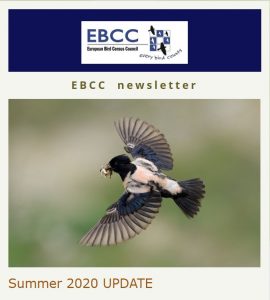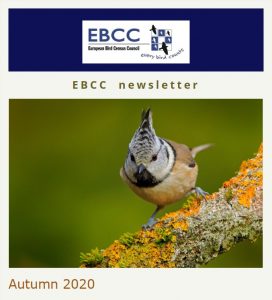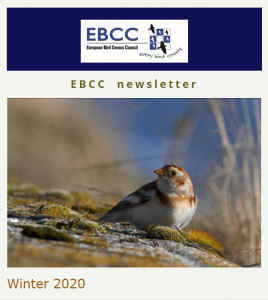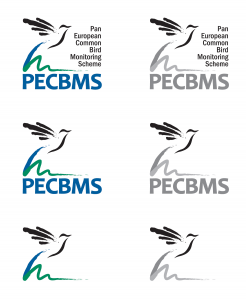Report on the Pan-European Common Bird Monitoring Scheme, December 2020
January 7, 2021
This report summarizes the activities of the Pan-European Common Bird Monitoring Scheme (PECBMS) between July 2020 and December 2020.
Project funding
The project is secured by the EC tender called “Technical and scientific support in relation to the delivery and development of wild bird indicators for the EU“.
Technological development and improvement of data flow and analyses
The plan of a data revision was prepared, the criteria were discussed and set. The analyses were prepared in R and scripts for a table with criteria (needed for quantification of whole decision process) were written. The data revision started and until the end of 2020, approximately 75% of the data revision was finished. It is planned to be completed until 31 March 2021.
Presentation of results and promotion
PECBMS contributed to all EBCC Newsletters published in the reporting period and spread to more than 400 recipients, see an archive of the newsletter.



PECBMS website www.pecbms.info has been actualised on regular basis. Since April 2020 we have published eight news, updated the publications, PECBMS methods, and the information on the bird monitoring schemes in Europe.
During the summer we surveyed the production of national bird indicators across the EU Member States. We have updated the overview of the national bird indicators on the website, too.
PECBMS news items were regularly published on the FB account of EBCC, which serves as a promotional platform for all EBCC projects (59 news since April 1st).
The first official logo of the PECBMS has been developed in cooperation with a graphic designer. Members of the Project Steering Group have chosen the final design from several versions.

Research
We have been working on the first PECBMS data paper, which presents an updated European dataset of annual indices and trends for the bird species as well as the methodology used for counting, national and European indices, and trends calculation. Moreover, it provides a brief overview of the applications of the data.
We have been involved in the preparation of the manuscripts regarding EU bird population change analysis (Fiona Burns, RSPB Centre for Conservation Science, research led by Richard Gregory) and an assessment of relative habitat use as a metric of species habitat association and specialization (Enya O´Reilly, Simon Butler, University of East Anglia).
We participate in a project aiming to advance the understanding of stability within and among ecosystems and across ecological scales (RSPB and the University of Sheffield). Anna Gamero is preparing the site-level data for this project.
We participate in a project called Turtle dove migration – a proposal for the delineation of flyways led by Hervé Lormée from Office Français de la Biodiversité and Carles Carboneras from Instituto de Investigación en Recursos Cinegéticos.
PECBMS data were used in the following publications:
- L. Paracchini, S. Condé, R. D’Andrimont, B. Eiselt, European Commission, Eurostat, Luxembourg; O. Fernandez Ugalde, E. Gervasini and A. Jones, V. Kovacevic, R. Oppermann, A. Orgiazzi, M. Van der Velde, C. Polce and C. Rega, C. Van Swaay, and P. Voříšek 2020: The challenge of monitoring biodiversity in agricultural landscapes at the EU level. Chapter in: Bárberi, P. and Moonen, A.-C. (ed.), Reconciling agricultural production with biodiversity conservation, Burleigh Dodds Science Publishing, Cambridge, UK, 2020. ISBN: 978 1 78676 348 8; http://www.bdspublishing.com
- BirdLife International 2020: Birds and biodiversity targets: what do birds tell us about progress to the Aichi Targets and requirements for the post-2020 biodiversity framework? A State of the World’s Birds report. Cambridge, UK: BirdLife International. ISBN no. 978-1-912086-67-2
- European Court of auditors: Special report 13/2020. Biodiversity on farmland: CAP contribution has not halted the decline. DOI: 10.2865/336742
- Trends of breeding waterbird populations in Europe based on the Pan-European Common Bird Monitoring Scheme data, 2020. Pan-European Common Bird Monitoring Scheme and Wetlands International, November 2020, Wageningen, The Netherlands. PDF
- Maggini I, Cardinale M, Favaretto A, et al. (2020): Comparing population trend estimates of migratory birds from breeding censuses and capture data at a spring migration bottleneck. Ecol Evol. 00:1–11. DOI: 10.1002/ece3.7110
- State of Europe’s Forests 2020 report. Available at https://foresteurope.org/publications/
Maintain and update the network of cooperating organizations and individuals
Up to date, the PECBMS mailing list contains 435 individual contacts from 64 countries or territories, including coordinators of national monitoring schemes, EBCC national delegates, and BirdLife partner organisations as well as policy people and decision-makers.
We provided advice and consultations to the national coordinators upon request, we met (on-line) e. g. the Greek or Serbian colleagues.
Reporting and assistance to the main stakeholders of the project, administration
We continue to work on the EC tender called “Technical and scientific support in relation to the delivery and development of wild bird indicators for the EU“ with the RSPB, Stichting BirdLife Europe, Catalan Institute for Ornithology (ICO), and University of East Anglia (UEA).
We have assisted Belarus with computing the indices of 15 species delivered and we are finishing the overall assessment of the scheme. Once the data is corrected, we will calculate the indices and assess their quality.
We have assisted Croatia with the assessment of their scheme and the quality of data. Once the quality-check is finished, we hope the Croatian indices of farmland birds could be involved in PECBMS indicators next year.
We helped to raise funds for breeding bird atlas in Ukraine via CSO fundraising.
We assisted the Belgian coordinator with data revision plans in Belgium and using RSWAN.
We are in contact with EUROSTAT and discussing Brexit and its implications for the EU indicators. In September, EU27 indicators (excluding the UK) were calculated and delivered to EUROSTAT.
We wish you all a healthy and happy New Year 2020!


